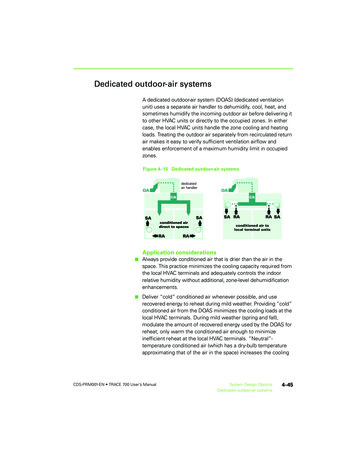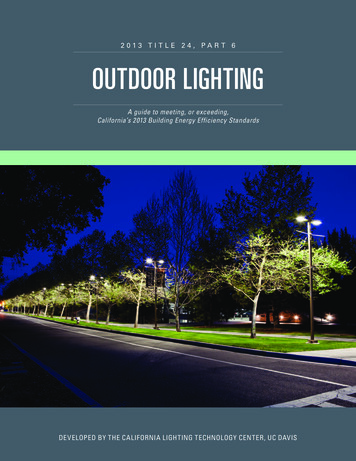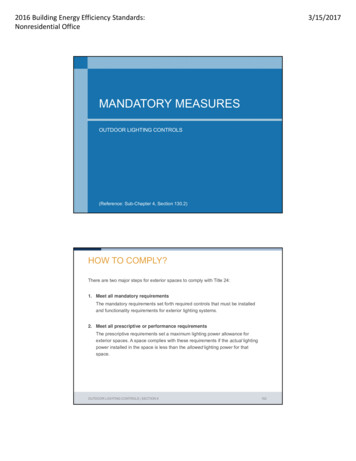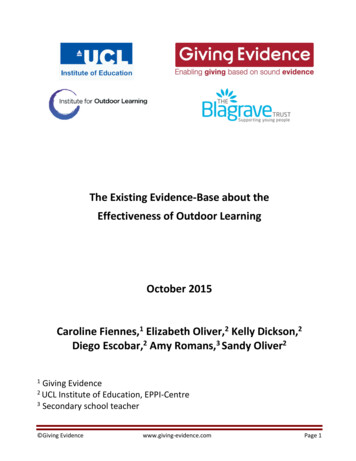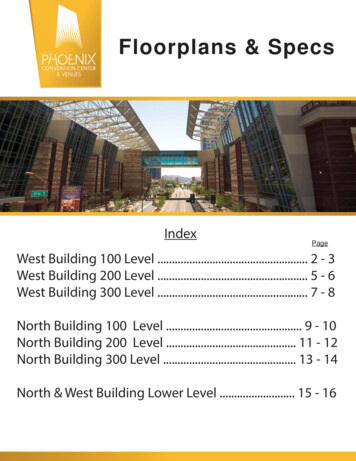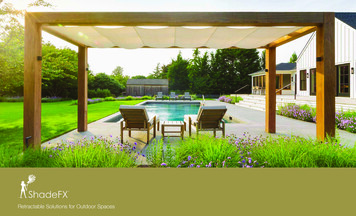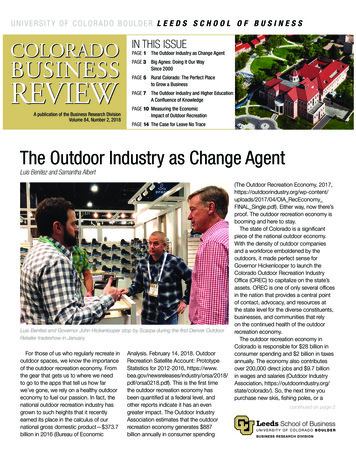
Transcription
UNIVERSITY OF COLORADO BOULDER L E E D S S C H O O L O F B U S I N E S SIN THIS ISSUEPAGE 1 The Outdoor Industry as Change AgentPAGE 3Big Agnes: Doing It Our WaySince 2000PAGE 5 Rural Colorado: The Perfect Placeto Grow a BusinessPAGE 7A publication of the Business Research DivisionVolume 84, Number 2, 2018The Outdoor Industry and Higher Education:A Confluence of KnowledgePAGE 10 Measuring the EconomicImpact of Outdoor RecreationPAGE 14 The Case for Leave No TraceThe Outdoor Industry as Change AgentLuis Benitez and Samantha AlbertLuis Benitez and Governor John Hickenlooper stop by Scarpa during the first Denver OutdoorRetailer tradeshow in January.For those of us who regularly recreate inoutdoor spaces, we know the importanceof the outdoor recreation economy. Fromthe gear that gets us to where we needto go to the apps that tell us how farwe’ve gone, we rely on a healthy outdooreconomy to fuel our passion. In fact, thenational outdoor recreation industry hasgrown to such heights that it recentlyearned its place in the calculus of ournational gross domestic product— 373.7billion in 2016 (Bureau of EconomicAnalysis. February 14, 2018. OutdoorRecreation Satellite Account: PrototypeStatistics for 2012-2016, 8/pdf/orsa0218.pdf). This is the first timethe outdoor recreation economy hasbeen quantified at a federal level, andother reports indicate it has an evengreater impact. The Outdoor IndustryAssociation estimates that the outdoorrecreation economy generates 887billion annually in consumer spending(The Outdoor Recreation Economy, s/2017/04/OIA RecEconomyFINAL Single.pdf). Either way, now there’sproof. The outdoor recreation economy isbooming and here to stay.The state of Colorado is a significantpiece of the national outdoor economy.With the density of outdoor companiesand a workforce emboldened by theoutdoors, it made perfect sense forGovernor Hickenlooper to launch theColorado Outdoor Recreation IndustryOffice (OREC) to capitalize on the state’sassets. OREC is one of only several officesin the nation that provides a central pointof contact, advocacy, and resources atthe state level for the diverse constituents,businesses, and communities that relyon the continued health of the outdoorrecreation economy.The outdoor recreation economy inColorado is responsible for 28 billion inconsumer spending and 2 billion in taxesannually. The economy also contributesover 200,000 direct jobs and 9.7 billionin wages and salaries (Outdoor IndustryAssociation, https://outdoorindustry.org/state/colorado/). So, the next time youpurchase new skis, fishing poles, or acontinued on page 2
backpack, let the numbers sink in. You,a passionate user of the outdoors, arecontributing to a thriving and innovativeeconomy.Yet, today we’re seeing the industryreach beyond traditional ideas ofsupporting the health of our industry.We’ve realized we’re more than just salesof skis, fishing poles, andbackpacks. A major shift istaking place—one in whichOREC hopes to capitalizeon and use to transformthe outdoor industry into apowerful force for economicdevelopment, conservation,education, and wellness.Through OREC, communitiesacross Colorado are unitingand becoming empoweredto advocate for and stewardthe resources that enable ourpassions. After all, our landsand waters are the backboneof our outdoor experiences,and thus, our outdooreconomy.Across the nation, we arebeginning (and continuing)important conversationsabout access to, diversity in, and (over)use of our outdoor spaces. We’re tacklingtough conversations about public lands,and the role of people and outdoororganizations in promoting and protectingthese spaces. Recently, the State of theRockies Project’s 2018 Conservation inthe West poll, released at the first OutdoorRetailer tradeshow in Denver, shows that96% of Coloradans believe the industryis essential to the economic future of ourstate, and a majority think our public landsgive us an advantage over other states(Conservation in the West, 2018 StateFact Sheet, ionintheWest 2018StateFactSheet Colorado.pdf). This is notinsignificant.As we seek solutions for the issueswe’re facing, our conversations haveranged from pay-to-play models fortraditionally underfunded recreation, to2 COLORADO BUSINESS REVIEWbetter promoting concepts like LeaveNo Trace for those who live in or visit ourbeautiful state. Our continued use of thesespaces relies on shifting the mindsets ofall residents and visitors to supportingand stewarding these spaces we use andlove. We’re also encouraging outdoorusers to look beyond traditional modesof recreation. New product trends likee-bikes and stand up paddle boards areinnovative recreation experiences thatmerge with traditional user experiences.Moving forward, we’ll need to find a wayto support this type of innovation in ourindustry.This is the beauty of the outdoorrecreation industry. We’re constantlyinnovating and evolving to supportgrowing needs. We’re inspired by ourenvironments to create beautiful andeffective products, and we’re also inspiredto support the outdoor spaces thatsupport our livelihoods. Our mission atOREC is just this—to inspire industriesand communities to thrive in Colorado’sgreat outdoors. We want to enhance theoutdoor experience for all, and we do thisby supporting economic developmentand also by focusing on conservation andstewardship, education and workforcetraining, and health and wellness. We hopethis holistic approach to outdoor recreationwill allow future generations of Coloradansto explore and benefit from the outdoorspaces that make our state a beautifulplace to live, work, and play.Luis Benitez, Director, Colorado OutdoorRecreation Industry Office, steppedinto his current role with the OutdoorRecreation Industry Office(OREC) when the agencywas established in 2015by Governor Hickenlooper.His early career was spentconducting mountaineering,climbing, and skiing coursesfor the Outward Bound. WhileLuis still guides for OutwardBound through his EndeavorConsulting Company, an evenmore intense occupationcaptured his imagination:high altitude mountaineering.Through Endeavor Consultingand other organizations, Luishas led parties of climbers tothe summit of some of Earth’smost imposing peaks.Luis’ climbingachievements are only oneof many reasons why he iswhere he is today. He’s fortunate to havebeen able to transfer the fearless passionand leadership he honed in the mountainsto our state’s flourishing outdoor recreationindustry. Through OREC, Luis is able tosupport the booming outdoor economywhile also watching communities becomeempowered to advocate for and stewardthe resources that enable all of ouradventurous pursuits and passions. Hemay be contacted at luis.benitez@state.co.us. For more information on OREC, s/outdoor-recreation-industryoffice.Samantha Albert is the OperationsManager of the Colorado OutdoorRecreation Industry Office. She may becontacted at samantha.albert@state.co.us.
Big Agnes: Doing It Our WaySince 2000Len ZanniWe’re often asked, “Is there somethingin the water up there in Steamboat?”Folks from out of town wonder why thereseem to be so many successful outdoorindustry brands and organizationsbased in Steamboat Springs, Colorado.Big Agnes was founded in 2000 inSteamboat Springs so the location’s apart of our brand’s DNA. When our cofounder and president Bill Gamber tookhis first sleeping bag with an integratedpad sleeve to the Outdoor Retailertradeshow, he was told by a respectedindustry business editor, “Sleeping bags?The market is too saturated, you’ll neversurvive and be profitable against the bigbrands that already own the category.”That’s when Bill really started to believewhat he already knew: it’s going totake a scrappy, innovative approach, acommitment to the outdoors he loved,and never forgetting the “advice” of thenaysayers.Fast forward 18 years and Big Agneshas remained anchored to the valuesof being outdoors; creative, innovativethinkers; comradery driven; andcommitted to the adventurous lifestylethat comes along with it all. Steamboatis special because it allows thatbusiness model and focus to be kept inperspective right outside our office doors.We are minutes away from endless trailsand campsites that offer optimal product-testing grounds. Our staff of eagervolunteers is ready to take on the taskof a night out to make sure a prototypetent has adequate vestibule space tostore their bikes, dogs, and fishing gear.It’s a tough job but one that’s actuallypertinent to our product developmentteam. Our brand needs this type ofreal-world application at a moment’snotice, and Steamboat Springs fits thebill. This outdoors-centric lifestyle is alsoa big reason why we’ve retained suchgreat staff, but the cost of real estate anddistance from a major airport and city canalso be hurdles for others. Those thingsthat make living in Steamboat financiallycontinued on page 4Photo: Noah WetzelCOLORADO BUSINESS REVIEW 3
and logistically challenging are realities ofoperating a global business in the city, too.We’ve spent a great deal of time andresources over the past few years towork on improving our structure andlogistics. This includes consolidating,along with sister company Honey Stinger,various offices spread across town to oneheadquarters building less than a milefrom the base of Steamboat Ski Area.This winter saw a lot more of us skinup the mountain in the morning beforework or ski at lunch more than timeused to allow. Our new facility housesIt’s not just our hometown locationthat has kept us going all these years.It’s also being located in a great statelike Colorado—from the access to adiverse landscape; to long-standing retailpartners; to nonprofits that we work withlike Colorado Fourteeners’ Initiative, SOSOutreach, and the Continental DivideTrail Coalition; to the Governor-appointedOutdoor Recreation Advisory Group thatGamber is a part of with Luis Benitez.Colorado is a forward-thinking state thathas the outdoor industry, public lands,and growing businesses to help push usall to be better, do more, and contributeto in ways we have maybe always wantedbut didn’t know how or did not have theresources to do it.If you ask where we’ll be in another 5 orPhoto: Noah Wetzel 10 years, you’d likely get a shrug and ananswer something like “still having fun andover 60 of our 110 employees workingtesting product in Steamboat.” While thatacross a variety of disciplines, like productis true, I’d like to also think we’ll still bedevelopment, marketing, sales, warranty/fired up, keeping the outdoor industry andrepair, and customer service, most ofour competitors on their toes. We’ve madewhom are here in northwest Colorado. Init this far doing it our way, and we have noaddition, we opened a fulfillment center inplans to change anytime soon.Utah and third-party fulfillment centers inCanada and Rotterdam in the NetherlandsLen Zanni is the Co-Owner and Headto help meet the growing internationalof Marketing for Big Agnes and Honeydemand for our products. These projectsStinger. Learn more about the brand atwere challenging but like any goodbigagnes.com.adventure, we were pushed out of ourcomfort zone and ended up with positiveresults that should help us continue to grow.Photo: Noah Wetzel4 COLORADO BUSINESS REVIEW
Rural Colorado: The PerfectPlace to Grow a BusinessSarah ShraderTerra-Flight Broadmoor Bridge PlatformAlmost 15 years ago, we started ourcompany, Bonsai Design, in GrandJunction, Colorado. Initially, we operatedout of our basement, with me managingfield crew logistics and running payrollwhile our three boys napped and playedin the backyard, and my brother andhusband leading a small crew in thefield building aerial adventures—fromziplines to challenge courses—all overNorth America. To date, we’ve installedmore than 500 ziplines, some as long as3,600 feet, and designed tours that lastas long as four hours, drawing tens ofthousands of adventure seekers a year.Our company continues to grow, nowwith over 50 employees, designing andconstructing projects across the country,manufacturing components to sellworldwide, training guides and inspectingcourses, and creating standards andefficiencies within the industry.Luckily, our business has prosperedtremendously in the Grand Valley. Mostof our employees are hired locally, witha talent pool of outdoor enthusiasts, aswell as energy and construction workers.We are also fortunate to work with anincredible group of subcontractors—localfabricators, machinists, and engineers—to create innovative adventures forparticipants. These hard-working, toughpeople are the lifeblood of our companyand an example of the kind of folks wholive in Mesa County.Our family and our employees havealso thrived by making this communityBonsai’s home. Being a “Western-Sloper”means that no matter what our politicsor religion may be, we all agree that thenatural landscape—the Colorado NationalMonument, the Grand Mesa, and therivers that give us the name of our town,to name a few—are a defining part ofour heritage and identity. No matter whatour differences, we are all connected bythese natural assets that make up whowe are on the Western Slope. With 75%of Mesa County made up of public lands,you can fish, climb, hunt, trail run, ski,hike, mountain bike, OHV, and paddle theColorado River on a regular basis withlittle to no traffic. At Bonsai, we are luckyenough to grow our families in a placewhere they have direct access to wildspaces.Rural communities all over the UnitedStates have suffered tremendously overthe last few decades. A combination offactors have contributed to this economicdownturn in rural America. First, manyof these rural communities have beendependent on one industry for theireconomic sustainability. Whether it berail, mining, agriculture, or oil and gasextraction, these communities didn’tdiversify their income, so when thoseindustries became either obsolete orcontinued on page 6COLORADO BUSINESS REVIEW 5
were subject to fluctuations in commoditypricing, they had nothing to fall backon. Furthermore, most states incentivizecompanies to relocate or grow in urbanand suburban areas, because theinfrastructure—including broadband—isalready in place for businesses to besuccessful. This economic developmentin urban and suburban areas hasinadvertently hurt rural economies. InColorado, our rural communities haveespecially been hit hard because ofTABOR. We haven’t been able to offsetthe decimation to funding in our schoolsand roads because our communitieshaven’t had the local dollars to raisetaxes.Yet, as a business owner of a companygoing through second-stage growth, I ama strong believer that rural communitieslike Grand Junction are the perfect placesto grow strong, sustainable companies.Quality of life, like what we have here inMesa County, is a driving force in theeconomy. The outdoor recreation industryin Colorado contributes 28 billion inconsumer spending and accounts for229,000 jobs in the state, making it akey industry for the state. According tothe Outdoor Recreation Coalition, theoutdoor industry in the Grand Valleycontributes more than 300 million tothe local economy. We know that the keyto wealth is diversifying our economicdrivers. Rural Colorado communitiesneed strong, diverse local economiesthat will provide secure, long-term jobs.The outdoor recreation industry is a keycomponent in economic vibrancy—itattracts businesses to grow here becauseof the recreation and beauty we have tooffer to employees and business owners.From the farms and wineries that producedelicious food and drink on the east endof the valley in Palisade, to the mountainbike trails and festivals on the west endof the valley in Fruita, our valley is a richplace for employees to explore and enjoy.Tech, aviation, manufacturing, and healthcare companies provide high-payingjobs and have an opportunity to grow inthis valley. With affordable office space,a plethora of supportive infrastructure,and inexpensive housing, as well6 COLORADO BUSINESS REVIEWAspen Snowmass Challenge Courseas unsurpassed outdoor recreationopportunities for employees, this is theideal place to grow a business.Furthermore, rural economies are rifewith hard-working people who wantto collaborate and work together tohelp their communities move forward.Recently, a group of business ownersfounded the Outdoor RecreationCoalition of the Grand Valley (ORC)in order to expand and enhance theeconomy of through collaborativesupport and promotion of outdoorrecreation businesses and resources.Since then, we’ve worked on efforts toincrease world-class mountain bike trailsfrom Fruita to Palisade. We’ve createdalliances with the energy industry in ajoint effort to diversify our economy. We’reworking with Colorado Mesa Universityto promote our community as an outdoorrecreation hub for college students inthe state. We worked hard to pass a 140 million school funding measurewith overwhelming community support.And a new outdoor recreation-basedbusiness park broke ground this spring,with a beautiful campus on the shores ofthe Colorado River designed to attractemerging businesses to our community.Those of us who are raising kidsand growing businesses here in MesaCounty often talk about how lucky weare. After all, being on a trail five minutesfrom your front door is pretty sweet. Nolines, no traffic, a great downtown, agrowing university, outdoor opportunitiesat your fingertips, and a tough andresilient community: We are the Coloradoeveryone was promised when theymoved to our great state. Come see uson the Western Slope, or as we call it: the#westslopebestslope.Sarah Shrader is Owner and CoFounder of Bonsai Design in GrandJunction, Colorado. She may becontacted at sshrader@bonsai-design.com. Visit http://bonsai-design.com tolearn more about the company.
The Outdoor Industry and Higher Education:A Confluence of KnowledgeJoel Hartter and Ian StaffordMENV Faculty Director Joel Hartter and Rocky Mountain National Park rangers discussing collaborative management atRocky Mountain National Park with MENV graduate students, August 2017.As the first streaks of light toucha snowcapped Mt. Princeton in theSawatch Range, the Arkansas Rivercontinues to churn on its eastwardquest to eventually meet with the mightyMississippi. Rafting guides can beheard rolling out of their tents, anglersare already wading their way into herrolling waters, and tourists are anxiouslyanticipating their “Colorado” experience.The Arkansas Valley is just one exampleof many areas throughout Coloradothat thrives, due in large part to theoutdoor industry, by leveraging wildplaces and open spaces to bolster anddiversify local economies. With PresidentObama signing the Outdoor RecreationJobs and Economic Impact Act (RecAct) in November 2016, the industry’seconomic impact is now included in thenational GDP. According to the Bureau ofEconomic Analysis, the outdoor industrygenerated 374 billion in economicactivity, 2% of the country’s GDP, anda total gross output of 673 billion in2016 (U.S. Department of Commerce,and Bureau of Economic Analysis. NewsRelease: Outdoor Recreation SatelliteAccount, February 14, 2018, ease.htm). In Coloradoalone, according to the Outdoor IndustryAssociation, the outdoor economygenerates 28 billion in consumerspending and provides over 229,000direct jobs (Outdoor Industry Association.“Colorado’s Outdoor w leaders are needed to ensurethat wild lands and open space remainaccessible, conserved, and managedin a sustainable way. The Masters ofthe Environment (MENV) GraduateProgram at the University of ColoradoBoulder is positioned to do just that. TheMENV Graduate Program is a 17-monthintensive professional master’s programcontinued on page 8COLORADO BUSINESS REVIEW 7
that equips students with the knowledge,skills, and experience necessaryto address complex environmentalchallenges of the 21st century. Throughthis comprehensive approach toprofessional education, MENV studentsreceive a graduate degree from one ofthe world’s preeminent universities inenvironmental and natural sciences,while simultaneously gaining valuableprofessional experience through projectbased learning, professional developmentworkshops, and the Capstone Project.The MENV Graduate Programprepares leaders today to help shapethe conversation on use of wild andopen spaces that support the outdoorindustry as it continues to grow. Studentstake courses in environmental science,leadership, ethics, and systems thinking,and then they track into specializationsin environmental policy, sustainabilityplanning, sustainable food systems, orrenewable energy. Project-based learningprovides an important opportunity forstudent inquiry in real-life situations. Forexample, the Sustainable Communitiesand Sustainable Livelihoods coursefocuses on Colorado communitieswhose futures are intertwined withwild places and the connection torecreation economies. Solving complexproblems in rural communities meansthat students must understand cultural,economic, and political underpinnings.This project-based course partners withColorado Blueprint and the ColoradoOffice of Economic Development andInternational Trade. Students spend thesemester paired with a rural Coloradocommunity, assisting in identifying growthopportunities in the outdoor recreationlandscape and positioning communitiesto improve reach and impact in themarketplace that will be sustainable.Last fall MENV students were partneredwith the town of Craig, a town that iscurrently going the process of shuttingdown a major coal plant and needs tofind new ways to generate income. Withthe pristine Yampa River running at theedge of town, the community is hopingto start development of infrastructureto support commercial river raftingoperations. Students also workedwith Summit County, the USDA ForestService, and other stakeholders toexplore possible managing solutions tothe overcrowding at Quandary Peak nearBreckenridge. Working hand-in-handwith the people in the community andlocal leaders in industry and government,students co-developed a vision for newrecreation opportunities for the townof Craig and a strategy to manageQuandary Peak’s visitors, access, andresource impact that accounts forthe growing popularity of Colorado’sfourteeners.A hallmark of the program is theCapstone Project—a full calendar-yearimmersive project where students serveMENV students learning about wildfire management in the wildland urban interface from The Nature Conservancy staff at the site of the ColdSprings Fire, a 528-acre fire that burned near the town of Nederland, August 2017.8 COLORADO BUSINESS REVIEW
MENV students learning about the complexities of a record-number of visitors to America’snational parks and managing the impacts to wildlife and the natural environment, RockyMountain National Park, August 2017.as consultants and staff in companies,organizations, or government offices.Capstone partners span a broadspectrum of organizations involved inenvironment, energy, and planning.Many MENV students choose to workwith leading organizations in the outdoorindustry and those focused on landmanagement in the U.S. West. Over thelast two years, these partners include theOutdoor Industry Association, WesternResource Advocates, the National ParksConservation Association, Aspen SkiingCompany, Vail Resorts, and The NatureConservancy, among others. LindsayBourgoine of Protect Our Winters says,“Protect Our Winters really valued servingas a Capstone partner and hosting anMENV student in 2017. As a small nonprofit, capacity challenges are very real,and it was an incredible opportunity forus to add significant capacity all whilegiving back and mentoring a studentin the entrepreneurial environment of ayoung non-profit.” Being able to providestudents with this type of first-handknowledge is important and a positiveexperience for both students andsponsoring organizations.Altogether, the MENV GraduateProgram will hone students’ professionalskills, such as project management,stakeholder engagement, analysis,collaboration, and financial planning,which will be essential for students to hitthe ground running from day one withtheir clients. MENV students are highlymotivated graduate students, equippedwith prior professional experience,who will provide innovative solutionsand actionable recommendations toCapstone client organizations.The United States is globally recognizedas a leader in outdoor recreation. Asa multidimensional economic sector,outdoor recreation fuels employment inother sectors, such as manufacturing,finance, retail, transportation, foodservice, tourism, travel, and more.In 2017, over 144 million Americansrecreated in the outdoors, national parksattendance reached over 300 millionvisitors, and the outdoor industry showedgrowth at a staggering level (OutdoorIndustry Association. 2017 ParticipationReport, 2017-ToplineReport FINAL.pdf). The national outdoorindustry grew at 3.8% rate, compared tothe overall U.S. economy’s 2.8% growth,in 2016. Further, the industry accountedfor 7.6 million jobs and an estimated 65.3 billion in federal tax revenue, aswell as 59.2 billion in state and local taxrevenue (Outdoor Industry Association.The Outdoor Recreation Economy,2017 report, 7/04/OIARecEconomy FINAL Single.pdf).The outdoor industry is not just forguides and outfitters. It is an industrythat blends the worlds of productdevelopment, tech, land management,billion-dollar retailers, and the list goeson. In order for this industry to growto its potential, it needs leaders thatunderstand how to talk-the-talk andwalk-the-walk. As communities investin outdoor infrastructure that attractsemployers and active workforces, thosecommunities may thrive economicallyand socially, but new economies bringchallenges and changes to the placeswhere we love to play and the brandsthat we associate with recreation. Weneed leaders who are ready and willingto tackle issues that cut across business,policy, and stewardship. The MENVGraduate Program at the University ofColorado is helping blaze that trail todevelop the next generation of leaders inthe outdoor industry.Joel Hartter is an Associate Professorand Faculty Director of the Masters of theEnvironment Graduate Program at theUniversity of Colorado Boulder. He may becontacted at joel.hartter@colorado.edu.Ian Stafford is an environmental policystudent in the Masters of the EnvironmentGraduate Program. He may be reachedat ian.stafford@colorado.edu.COLORADO BUSINESS REVIEW 9
Measuring the EconomicImpact of Outdoor RecreationMichael HansenWhile outdoor-related activities provideAmericans with countless health,recreation, and entertainment leisurebenefits, they also make a substantialeconomic impact. In February 2018,the Bureau of Economic Analysis (BEA)released its first-ever estimates of theeconomic contribution of outdoorrecreation to the U.S. economy.According to the BEA’s early prototypestatistics, outdoor activities added 373.7 billion to the national economyin 2016, making up 2% of the entireU.S. GDP. The BEA analyzed the impactof outdoor recreation over a five-yearperiod from 2012 to 2016, measuringthe gross output for a wide array ofoutdoor-related activities and the valueadded by industries interacting withoutdoor recreation. Growth in the outdoorrecreation economy outpaced the overallU.S. economy in 2016—value added byoutdoor recreation grew by 3.8% whilethe U.S. GDP grew by just 2.6%. Theoutdoor industry grew faster than thedomestic economy for three out of thefour years between 2013 and 2016.Outdoor recreation activities definedby the BEA are divided into threecategories: conventional outdooractivities, other outdoor activities, andactivities supporting outdoor recreation.Conventional activities include typicaloutdoor activities such as camping,hiking, skiing, hunting, boating, andmotorized activities. The other activitiescategory includes activities that involvethe outdoors, such as amusement parks,agricultural tourism, and outdoor festivals.Finally, supporting activities compriseconstruction, travel, and governmentexpenditures that support all of theseactivities. These supporting activitiescould include the construction of newhiking trails or improvements to NationalPark Service infrastructure.OUTDOOR RECREATION VALUE ADDED VS GDPAnnual Change7%U.S.Nominal GDP6%5.8%Outdoor Rec Value urce: Bureau of Economic Analysis, Outdoor Recreation Satellite Account.Outdoor Recreation ActivitiesCon ven ti on al Acti vi ti esOth er Acti vi ti esBicycling Amusement Parks/Water Parks Boating/Fishing Festivals/Sporting Events/Concerts Camping/Climbing/Hiking Field Sports Equestrian Game Areas (including Golf and Tennis) Hunting/Shooting/Trapping Guided Tours/Outfitted Travel Motorized Vehicles Productive Activities Recreational Flying Other Outdoor Recreation Activities Skiing Snowboarding Other Conventional Activities Supporting Outdoor Recreation Construction Trips and Travel Government ExpendituresSource: Bureau of Economic Analysis, Outdoor Recreation Satellite Account.10 COLORADO BUSINESS REVIEW3.8%3.4%3.3%
The BEA measures the impact ofthese individual activities in terms ofgross output estimated through salesor receipts for goods and servicesassociated with the particular activity. Forexample, gross output associated withskiing could include the physical skis andaccessories, apparel, repair services,and lift tickets. Additionally, gross outputincludes sales to both final users andother intermediate industries. In 2016,the total gross output associated withoutdoor recreat
His early career was spent conducting mountaineering, climbing, and skiing courses for the Outward Bound. While Luis still guides for Outward Bound through his Endeavor Consulting Company, an even more intense occupation captured his imagination: high altitude mountaineering. Through Endeavor Consulting and other organizations, Luis


